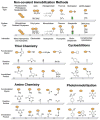Glycan microarrays for decoding the glycome
- PMID: 21469953
- PMCID: PMC3116967
- DOI: 10.1146/annurev-biochem-061809-152236
Glycan microarrays for decoding the glycome
Abstract
In the last decade, glycan microarrays have revolutionized the analysis of the specificity of glycan-binding proteins (GBPs), providing information that simultaneously illuminates the biology mediated by them and decodes the informational content of the glycome. Numerous methods have emerged for arraying glycans in a "chip" format, and glycan libraries have been assembled that address the diversity of the human glycome. Such arrays have been successfully used for analysis of GBPs, which mediate mammalian biology, host-pathogen interactions, and immune recognition of glycans relevant to vaccine production and cancer antigens. This review covers the development of glycan microarrays and applications that have provided insights into the roles of mammalian and microbial GBPs.
Figures





References
-
- Varki A, Cummings R, Esko J, Freeze H, Stanley P, et al. Essentials of Glycobiology. New York: Cold Spring Harbor; 2009. p. 830. - PubMed
-
- Kulkarni AA, Weiss AA, Iyer SS. Glycan-Based High-Affinity Ligands for Toxins and Pathogen Receptors. Medicinal Research Reviews. 2010;30:327–93. - PubMed
-
- van Kooyk Y, Rabinovich GA. Protein-glycan interactions in the control of innate and adaptive immune responses. Nat Immunol. 2008;9:593–601. - PubMed
-
- Crocker PR, Paulson JC, Varki A. Siglecs and their roles in the immune system. Nat Rev Immunol. 2007;7:255–66. - PubMed
-
- Taylor ME, Drickamer K. Paradigms for glycan-binding receptors in cell adhesion. Curr Opin Cell Biol. 2007;19:572–7. - PubMed
Publication types
MeSH terms
Substances
Grants and funding
LinkOut - more resources
Full Text Sources
Other Literature Sources

